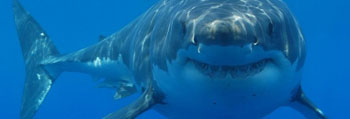
Sharks have upper and lower eyelids but they do not blink.
Sharks can travel up to 40 miles per hour.
The most harmless sharks tend to be the largest.
There are 370 species of sharks.
Some sharks swim in a figure eight when frightened.
Sharks have survived on earth for about 400 million years.
A shark bites with it's lower jaw first and then its upper.
Some sharks may eat other sharks.
The hides of mature female blue sharks are more than twice as thick as those of males.
Sharks’ wounds heal quickly and they rarely get tumors.
A shark may grow and use over 20,000 teeth in its lifetime
Almost all sharks are "carnivores" or meat eaters.
A great white shark can go three months without eating.
Great white sharks will eat any other creature found in the ocean.
A great white shark loses teeth when striking a meal and will grow thousands during its lifetime.
A great white shark will eat a meal and immediately start looking for the next prey.
A great white shark cannot get cancer.
More than half of sharks give birth to pups, yet are still classified as fish.
Great white sharks are found in every ocean and at every depth.
A great white shark can be 20 plus feet long and weigh as much as 4,000 pounds.
Great white sharks are known to charge boats for no discernible reason.
A great white shark can see extremely well and can differentiate different colors.
Great white sharks have only a few predators that attack them – man, Orcas and other great white sharks. Porpoises and sperm whales, however, are able to defend themselves against great whites by attacking the sharks.
Great white sharks are the only ocean predator known to stick their head above the surface of the water to look at prey.
Next to nothing is known about the mating habits of great white sharks, but we do know they give birth to five to 10 pups at a time.
Nobody knows how long great white sharks live. The best guess is 40 years.
Scientists can determine the age of a shark by counting the rings that form on its vertebra, much as you can count the rings on a tree to tell its age.
Great white sharks are hard to keep alive in captivity because they refuse to eat.
Most great whites in captivity die after 10 or 11 days.
On one occasion, a female great white remained in captivity for almost 200 days in San Francisco before being released into captivity.
The great white shark is an endangered species.
More people are killed by dogs each year than have been killed by great whites in recorded history. You are 1,000 times more likely to drown in the sea than you are to be bitten by a shark.
Florida averages the greatest number of shark attacks annually. The location with the most recorded shark attacks is New Smyrna Beach, Florida
